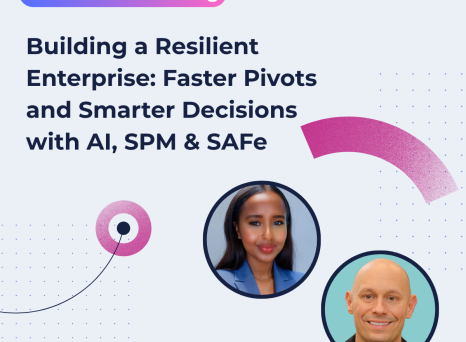Between 2019 and 2025, technological progress and market shifts have caused business change to accelerate by 183%, according to PMI. With disruption now a permanent state, organizational agility has become a critical requirement for companies across industries.
Project management offices (PMOs), operating at strategy’s intersection with execution, are uniquely positioned to seize this opportunity. As long as they embrace the right strategies, they can embed agility into organizational DNA as business evolution and digital acceleration continue.
The case for organizational agility
Agility—which can be defined as “the ability of an organization to renew itself, adapt, change quickly, and succeed in a rapidly changing, ambiguous, turbulent environment”—is not just about speed but about the ability to sense emerging threats and opportunities and act strategically to respond effectively.
Viewed by project professionals as one of the top drivers of project success, organizational agility gives businesses a measurable edge.
A good example is that of the management of the COVID-19 crisis. Agile organizations responded faster, adapted better, and outperformed non-agile peers during the pandemic:
- Empowered cross-functional teams made faster decisions without waiting for top-down directives
- Adaptive governance replaced static planning: leaders ran rapid, ad hoc reviews to re-prioritize work and allocate resources dynamically
- Real-time performance dashboards helped track progress and respond to bottlenecks with data-driven decisions
Quantitative benefits of enterprise agility
The benefits of business agility hold true in times of normalcy. On average, successful agile transformation delivers:
- +20 to +30 points improvement in employee engagement
- +10 to +30 points improvement in customer satisfaction
- 30% to 50% improvement in operational performance
- 20% to 30% improvement in financial performance
These are not abstract advantages, but measurable outcomes that can really move the needle in increasingly fast and competitive markets. Which begs the question: how can business and project leaders unlock these benefits?
As often in PPM, there’s of course no magic wand or recipe for enterprise agility, but adopting a set of proven best practices can help create an organizational structure for agile development.
3 foundational practices that power organizational agility
To thrive in fast-changing environments, organizations must embed agility not just in delivery teams but across the entire project and portfolio ecosystem. They can do this through structured change management, proactive risk management, and portfolio-level standards and governance.
1. Structured change management
Teams with strong change management capabilities consistently report higher levels of agility. 63% of high-agility organizations report they are “fostering a culture of continuous learning and openness to change,” versus 23% for their low-agility counterparts. This is because agility is not just about moving fast, but about helping people adapt to change smoothly and consistently.
PMOs can support this by integrating structured change plans into project lifecycles, ensuring change readiness is considered from the outset. They should conduct impact mapping to identify how changes will affect different stakeholders, systems, and business processes before implementation.
Additionally, PMOs can facilitate ongoing stakeholder engagement through forums, feedback loops, and alignment sessions to manage expectations, reduce resistance, and build trust throughout transformation efforts.
2. Proactive risk management
Traditional, static approaches to risk—such as annual registers—are no longer sufficient in volatile environments. To support agility, risk management must become continuous, adaptive, and forward-looking. Embedding this risk-conscious mindset into day-to-day operations can empower teams to maintain resilience and responsiveness rather than operating in a purely reactive mode.
To evolve their approach, organizations can implement rolling risk reviews at the portfolio level, which enables the identification of emerging threats and opportunities in real time. This involves weaving risk assessments into sprint planning and stage-gate reviews, ensuring that potential issues are considered during ongoing decision-making processes.
PMOs must also establish clear escalation paths for critical risks that threaten to derail time-sensitive or high-value initiatives. For example:
- If a project manager identifies a risk that could cause a significant delay or budget overrun, they escalate it directly to the PMO director, who evaluates the severity and determines the necessary actions to keep the project on track.
- In cases where risks are beyond the PMO's scope—such as a market shift or external supplier failure—the PMO director escalates the issue to the executive steering committee. This group assesses the strategic impact and decides on the necessary course of action at the portfolio level.
3. Portfolio-level standards and governance
A lack of alignment across teams harms agile organizational structures by causing slower decision-making, duplicated efforts, and inefficient resource allocation. This, in turn, can lead to fragmented customer experiences, missed innovation opportunities, and delays in scaling or adapting to market changes, ultimately hindering the organization’s ability to stay competitive.
Standardization, when balanced with flexibility, can create a strong foundation for scaling agility across portfolios.
This is why PPM leaders should create and enforce standard templates and workflows that promote consistency while still allowing teams to adapt based on project complexity or organizational maturity. They should embed agility-oriented principles directly into portfolio planning, review cycles, and prioritization processes, such as:
- Flow efficiency, which focuses on optimizing the speed and smoothness with which work moves through the system by identifying and eliminating bottlenecks and minimizing wait times between process stages.
- Work-in-progress limits that help prevent teams from taking on too much work simultaneously, ultimately leading to faster delivery and higher quality outcomes.
- Value stream thinking, which involves mapping and analyzing the entire flow of value from initial concept through to customer delivery, enabling organizations to identify waste, optimize processes, and ensure that every activity contributes meaningfully to delivering customer value.
Furthermore, PMOs must facilitate cross-team alignment by ensuring all stakeholders share a common language, operating cadence, and governance, even when working within hybrid project environments. This approach creates clarity, reduces friction, and empowers teams to deliver value in a coordinated and efficient manner.
PMOs can serve as accelerators by institutionalizing foundational practices that reinforce agility at scale. However, while processes are at the heart of agility, they must be supported by concrete tools, structures, and delivery methods that enable organizations to quickly respond and continuously deliver value.
4 practical enablers of business agility
To operationalize agility across teams and portfolios, businesses have long used time-tested frameworks and tools like Agile and other continuous delivery frameworks.
1. Agile and continuous delivery frameworks
Implementing Agile frameworks such as Scrum, Kanban, or hybrid approaches enables teams to deliver incremental value while continuously learning and adapting. These frameworks promote short feedback cycles, transparency, and greater responsiveness to changing priorities.
Practical tips for PMOs and delivery leaders:
- Embed Agile ceremonies (e.g. stand-ups, sprint planning, retrospectives) into team routines to create shared rhythms and fast course corrections
- Encourage visual workflows through Kanban boards or other timeline tools to manage work-in-progress and identify blockers early
- Support continuous delivery pipelines, enabling teams to release tested, production-ready increments frequently to reduce costly rework and long validation cycles
Agile has long been associated with technology projects; however, these practices lay the groundwork for enterprise agility in both software development and business operations.
2. Smart tools supporting agile operations
Project portfolio management tools play a vital role in improving flow efficiency, fostering alignment, and driving evidence-based decisions across organizations active in complex industries like finance or MedTech.
For example, Stevanato Group—a leading global provider to the pharmaceutical, biotechnology, and life sciences industries— was feeling increasing pressure to innovate and deliver faster. Adopting PPM technology helped them streamline product development and synchronize strategy, resources, and execution to scale innovation and enhance product development with speed and agility.
Practical tips for PMOs and delivery leaders:
- Provide real-time insights into project status, dependencies, and risks to enable cross-functional alignmentEnable cross-functional alignment, with real-time insights into project status, dependencies, and risks
- Facilitate structured decision-making, making it easier for executives and teams to course-correct or reallocate resources quickly
- Implement at scale to create transparency across portfolios, allowing leaders to track progress and identify issues at a glance.Enhance operational transparency across portfolios, allowing leaders to track progress and identify flow issues at a glance
- Bring these benefits into remote and hybrid environments by supporting collaborative workspaces
3. Outcome-focused performance metrics
Agility requires teams and leaders to measure outcomes, not just activity. Traditional metrics like on-time delivery or budget adherence can be misleading in fast-changing environments because they focus on process rather than impact. In rapidly evolving markets, a project might be completed on time and within budget, but still fail to deliver value or adapt to shifting customer needs.
To gauge success, organizations must track outcomes that reflect long-term value. These include customer satisfaction, market share growth, and the ability to pivot quickly in response to new insights or challenges.
Practical tips for PMOs and delivery leaders:
- Shift the focus from output to value, encouraging teams to define and track success through business impact (e.g. customer satisfaction, adoption rates, time-to-value).
- Standardize KPIs across portfolios while still allowing for flexibility based on project type (e.g. innovation vs. compliance).
- Leverage data from tools and dashboards to identify bottlenecks, track flow, and support continuous improvement.
Such metrics create a shared understanding of progress and value creation—key to sustaining agility over time.
4. Continuous learning culture
True agility depends on an organization’s ability to learn, adapt, and improve consistently and collectively. This means fostering a culture where teams actively reflect on both successes and failures, share insights, and apply lessons learned to future initiatives.
After all, agility isn’t just about individual performance; it requires collaboration across teams to adjust strategies, refine processes, and innovate together.
Practical tips for PMOs and delivery leaders:
- Foster transparency and shared accountability through daily stand‑ups, visible dashboards, and routine retrospectives that focus on learning rather than blame, with takeaways tracked and integrated into future planning.
- Encourage experimentation through low-risk pilots and iterative delivery models that reward progress over perfection.
- Invest in capability-building, from agile coaching and leadership development to peer learning networks and knowledge-sharing platforms.
By normalizing learning at every level, organizations build the confidence and competence to respond rapidly to change without sacrificing stability or quality.
Drive agility within your organization
By orchestrating structured change, embedding risk‑smart processes, operationalizing Agile frameworks, fostering a learning culture, and tracking outcome‑oriented metrics, PMOs can build the kind of agility that supports successful organizational change management.
Having the right tools can make all the difference.
Adaptive PPM solutions like Planisware allow PMOs to dynamically reprioritize initiatives, adjust plans, and shift funding as conditions and strategy evolve, thanks to:
- Frameworks for organizing portfolios to ensure alignment between work and investments.
- Dynamic management capabilities to consistently reassess priorities, reallocate funding, and update plans as strategies evolve.
- AI features to spot trends, reduce risks, and enable quicker decision-making
Eager to see how a modern project portfolio management tool can integrate change control, agile metrics, visual boards, and portfolio reporting into one seamless platform? Request your personalized demo today.


